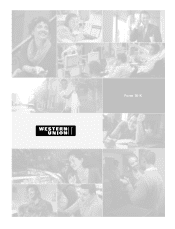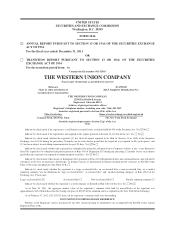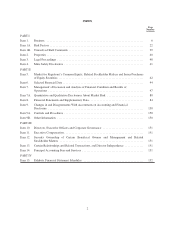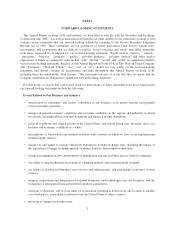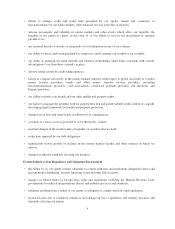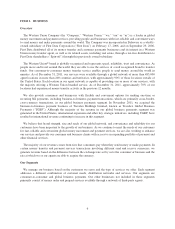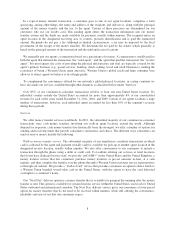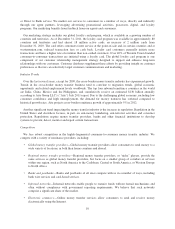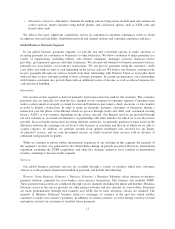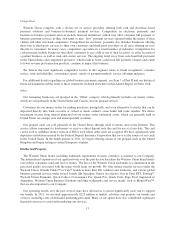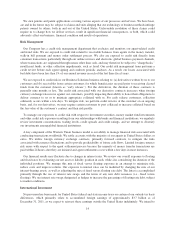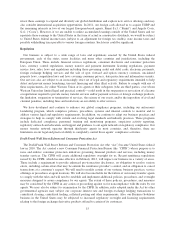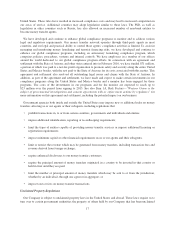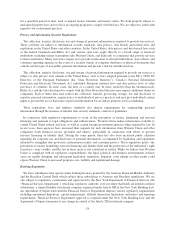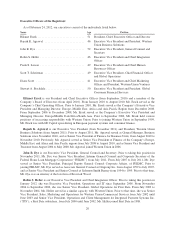Western Union 2011 Annual Report Download - page 17
Download and view the complete annual report
Please find page 17 of the 2011 Western Union annual report below. You can navigate through the pages in the report by either clicking on the pages listed below, or by using the keyword search tool below to find specific information within the annual report.or Direct to Bank service. We market our services to consumers in a number of ways, directly and indirectly
through our agent partners, leveraging advertising promotional activities, grassroots, digital, and loyalty
programs. Our marketing benefits from feedback from our agents and consumers.
Our marketing strategy includes our global loyalty card program, which is available in a growing number of
countries and territories. As of December 31, 2011, the loyalty card program was available in approximately 80
countries and territories and had almost 18 million active cards, an increase of 2 million cards from
December 31, 2010. The card offers customers faster service at the point-of-sale and, in certain countries and at
westernunion.com, reduced transaction fees or cash back. Loyalty card customers generally initiate more
transactions and have a higher rate of retention than non-carded customers. Over 40% of Western Union branded
consumer-to-consumer transactions are initiated using a loyalty card. The global loyalty card program is one
component of our customer relationship management strategy designed to support and enhance long-term
relationships with our customers. Customer databases supplement these efforts by providing insight on customer
preferences so that we can selectively target customer communications and marketing.
Industry Trends
Over the last several years, except for 2009, the cross-border money transfer industry has experienced growth.
Trends in the cross-border money transfer business tend to correlate to migration trends, global economic
opportunity and related employment levels worldwide. The top four inbound remittance countries in the world
are India, China, Mexico and the Philippines, and cumulatively receive an estimated $130 billion annually
according to Aite Group LLC’s (“Aite”) July 2011 report. Due to the challenging global economy, including low
consumer confidence and high unemployment, the demand for money transfers has softened compared to
historical growth rates. Aite projects cross-border remittance growth of approximately 5% in 2012.
Another significant trend impacting the money transfer industry is the increase in regulation. Regulation in the
United States and elsewhere focuses, in part, on anti-money laundering, anti-terrorist activities and consumer
protection. Regulations require money transfer providers, banks and other financial institutions to develop
systems to prevent, detect, monitor and report certain transactions.
Competition
We face robust competition in the highly-fragmented consumer-to-consumer money transfer industry. We
compete with a variety of remittance providers, including:
•Global money transfer providers—Global money transfer providers allow consumers to send money to a
wide variety of locations, in both their home countries and abroad.
•Regional money transfer providers—Regional money transfer providers, or “niche” players, provide the
same services as global money transfer providers, but focus on a smaller group of corridors or services
within one region, such as North America to the Caribbean, Central or South America, or Western Europe
to North Africa.
•Banks and postbanks—Banks and postbanks of all sizes compete with us in a number of ways, including
bank wire services and card-based services.
•Informal networks—Informal networks enable people to transfer funds without formal mechanisms and
often without compliance with government reporting requirements. We believe that such networks
comprise a significant share of the market.
•Electronic commerce—Online money transfer services allow consumers to send and receive money
electronically using the Internet.
10


